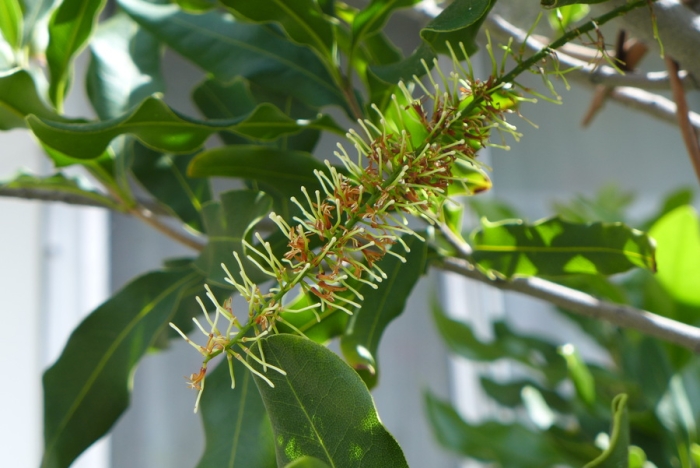Macadamia Nut
(Macadamia integrifolia)
Macadamia Nut (Macadamia integrifolia)
/
/

Jean Pawek
CC BY 3.0
Image By:
Jean Pawek
Recorded By:
Copyright:
CC BY 3.0
Copyright Notice:
Photo by: Jean Pawek | License Type: CC BY 3.0 | License URL: http://creativecommons.org/licenses/by/3.0/ | Attribution: 2019 Jean Pawek | Publisher: Calphotos | Notes: |









































Estimated Native Range
Summary
Macadamia integrifolia, commonly known as Macadamia Nut, is an evergreen tree native to subtropical rainforests in Eastern Australia, particularly in southeastern Queensland and northeastern New South Wales. It typically grows to a height of up to 49 feet (15 meters), with a dense crown. The tree features glossy, dark green leaves and produces fragrant flowers that are white to pale pink, blooming in spring and summer. The flowers are not particularly showy but are followed by the notable woody, edible fruits, which are rounded and 0.8 to 1.4 inches (2 to 3.5 cm) in diameter. These nuts are encased in a hard shell and are highly valued for their culinary use.
Macadamia Nut trees are cultivated for their delicious nuts, which are a significant commercial crop. They are also grown as ornamental trees in tropical and subtropical regions for their attractive foliage and the shade they provide. The trees require well-drained soils, consistent moisture, and protection from strong winds. They are not tolerant of frost and thus are limited to warm climates, such as USDA hardiness zones 10 and 11. While they can be grown from seed, commercial varieties are usually propagated by grafting to ensure nut quality and size. Potential problems include root rot in poorly drained soils and pests such as macadamia nut borer.CC BY-SA 4.0
Macadamia Nut trees are cultivated for their delicious nuts, which are a significant commercial crop. They are also grown as ornamental trees in tropical and subtropical regions for their attractive foliage and the shade they provide. The trees require well-drained soils, consistent moisture, and protection from strong winds. They are not tolerant of frost and thus are limited to warm climates, such as USDA hardiness zones 10 and 11. While they can be grown from seed, commercial varieties are usually propagated by grafting to ensure nut quality and size. Potential problems include root rot in poorly drained soils and pests such as macadamia nut borer.CC BY-SA 4.0
Plant Description
- Plant Type: Tree
- Height: 30-50 feet
- Width: 20-40 feet
- Growth Rate: Slow
- Flower Color: N/A
- Flowering Season: Spring, Winter
- Leaf Retention: Evergreen
Growth Requirements
- Sun: Full Sun, Part Shade
- Water: Medium
- Drainage: Medium
Common Uses
Bird Garden, Butterfly Garden, Edible*Disclaimer: Easyscape's listed plant edibility is for informational use. Always verify the safety and proper identification of any plant before consumption., Fragrant, Potted Plant
Natural Habitat
Subtropical rainforests in Eastern Australia, particularly in southeastern Queensland and northeastern New South Wales
Other Names
Common Names: Macadamia Nut, Smooth-Shelled Macadamia, Bush Nut, Nut Oakqueensland Nut
Scientific Names: , Macadamia integrifolia, Macadamia ternifolia var. integrifolia,
GBIF Accepted Name: Macadamia integrifolia Maiden & Betche